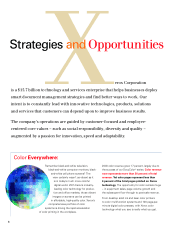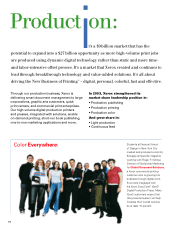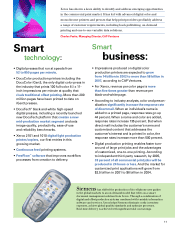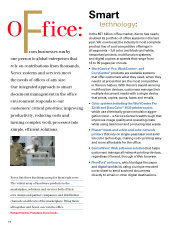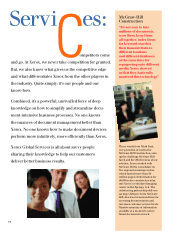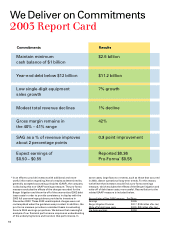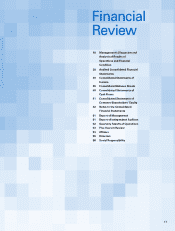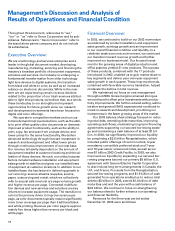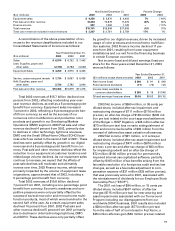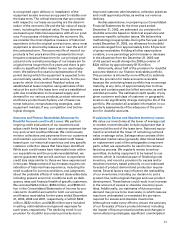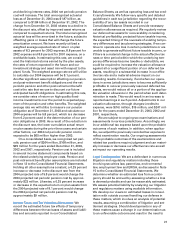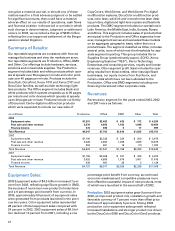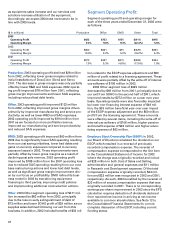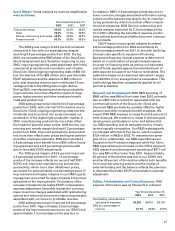Xerox 2003 Annual Report Download - page 20
Download and view the complete annual report
Please find page 20 of the 2003 Xerox annual report below. You can navigate through the pages in the report by either clicking on the pages listed below, or by using the keyword search tool below to find specific information within the annual report.
Throughout this document, references to “we,”
“our” or “us” refer to Xerox Corporation and its sub-
sidiaries. References to “Xerox Corporation” refer to
the stand-alone parent company and do not include
its subsidiaries.
Executive Overview:
We are a technology and services enterprise and a
leader in the global document market, developing,
manufacturing, marketing, servicing and financing the
industry’s broadest portfolio of document equipment,
solutions and services. Our industry is undergoing a
fundamental transformation from older technology
light lens devices to digital systems, the transition
from black and white to color, as well as an increased
reliance on electronic documents. While in the near
term we are experiencing certain revenue declines
related to the proportion of our total revenues attribut-
able to light lens products, we believe that, as a whole,
these trends play to our strengths and represent
opportunities for future growth since our research
and development investments have been focused on
digital and color offerings.
We operate in competitive markets and our cus-
tomers demand improved solutions, such as the abili-
ty to print offset quality color documents on demand;
improved product functionality, such as the ability to
print, copy, fax and scan from a single device; and
lower prices for the same functionality. We deliver
advanced technology through focused investment in
research and development and offset lower prices
through continuous improvement of our cost base.
Our revenue is heavily dependent on the amount of
equipment installed at customer locations and the uti-
lization of those devices. As such, our critical success
factors include hardware installation and equipment
sales growth to stabilize and grow our installed base
of equipment at customer locations. In addition to our
installed base, the key factors in delivering growth in
our recurring revenue streams (supplies, service,
paper, outsourcing and rental, which we collectively
refer to as post sale revenue) are page volume growth
and higher revenue per page. Connected multifunc-
tion devices and new services and solutions are key
drivers to increase equipment usage. The transition to
color is the primary driver to improve revenue per
page, as color documents typically require significantly
more toner coverage per page than traditional black
and white printing. Revenue per color page is approxi-
mately five times higher than revenue per black and
white page.
Financial Overview:
In 2003, we continued to build on our 2002 momentum
as evidenced by product installation and equipment
sales growth, earnings growth and an improvement
in our overall financial condition and liquidity. In a
relatively weak economic environment, we continued
our transition toward revenue growth and further
improved our business model. Our focused invest-
ment in the growing areas of digital production and
office systems yielded 21 new products. The success
of these products, combined with the 17 products
introduced in 2002, enabled us to gain market share in
key segments and deliver year-over-year equipment
sales growth in each quarter. These improved trends,
combined with favorable currency translation, helped
moderate the decline in total revenue.
We maintained our focus on cost management
throughout 2003. Gross margins remained strong as
we continued to offset price investments with produc-
tivity improvements. We further reduced selling, admin-
istrative and general (SAG) expenses and continued to
invest in research and development, prioritizing our
investments in the faster growing areas of the market.
Our 2003 balance sheet strategy focused on reduc-
ing total debt, extending debt maturities, improving
operating cash flows, maintaining long-term financing
agreements supporting our secured borrowing strate-
gy and maintaining a cash balance of at least $1 bil-
lion. In 2003, we significantly improved our liquidity
by completing a $3.6 billion Recapitalization, which
included public offerings of common stock, 3-year
mandatory convertible preferred stock and 7-year
and 10-year senior unsecured notes, as well as our
new $1 billion 2003 Credit Facility. In 2003, we also
improved our liquidity by expanding our secured bor-
rowing programs beyond our primary $5 billion U.S.
agreement with General Electric Capital Corporation
to also include long-term arrangements in Canada, the
U.K. and France. Proceeds from the Recapitalization,
secured borrowing programs, and $1.9 billion of cash
generated from operations enabled us to reduce total
debt by $3 billion in 2003, extend $1.6 billion of debt
maturities and end the year with a cash balance of
$2.5 billion. We continue to focus on strengthening
our balance sheet to further enhance our operating
and financial flexibility.
Revenues for the three-year period ended
December 31, 2003 were as follows:
18
Management’s Discussion and Analysis of
Results of Operations and Financial Condition


